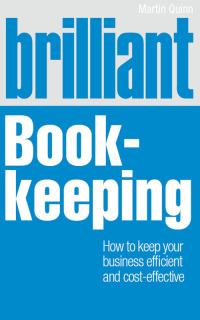Question
QUESTIONS: a. Assuming the company does not invest in the new product line, prepare forecasted income statements and Balance sheets at year-end 2010, 2011, and
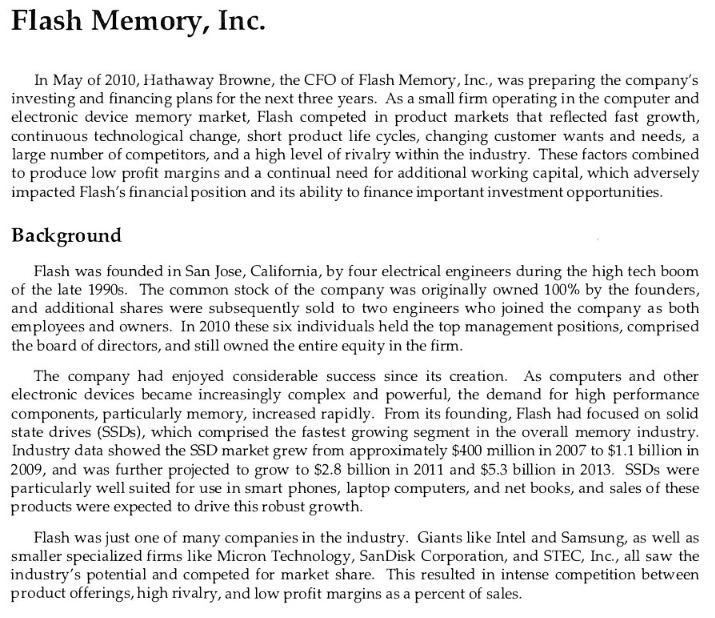
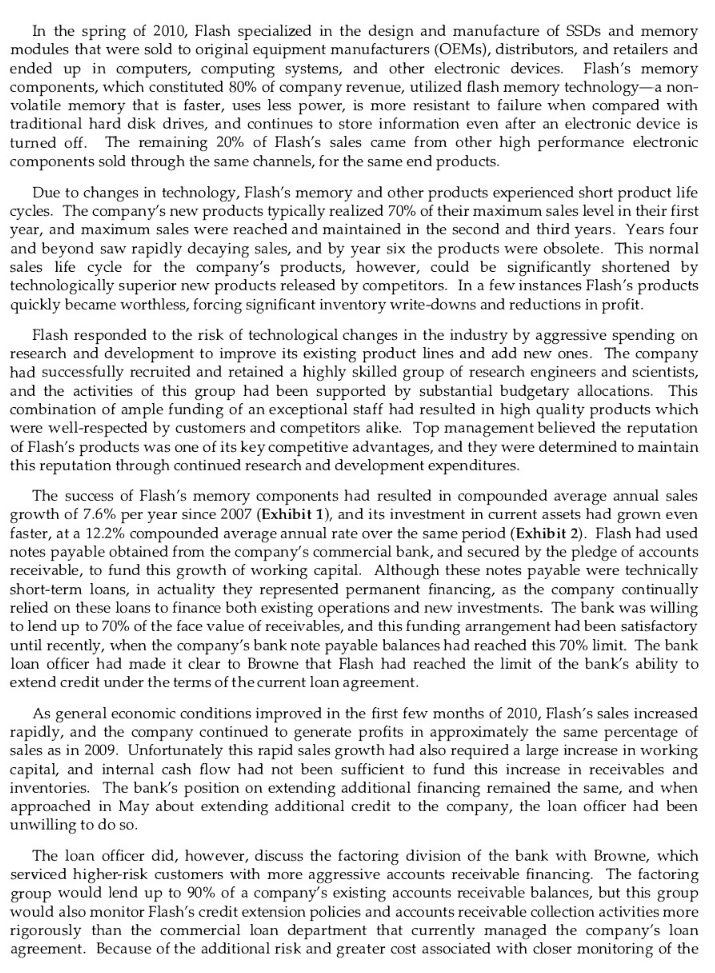
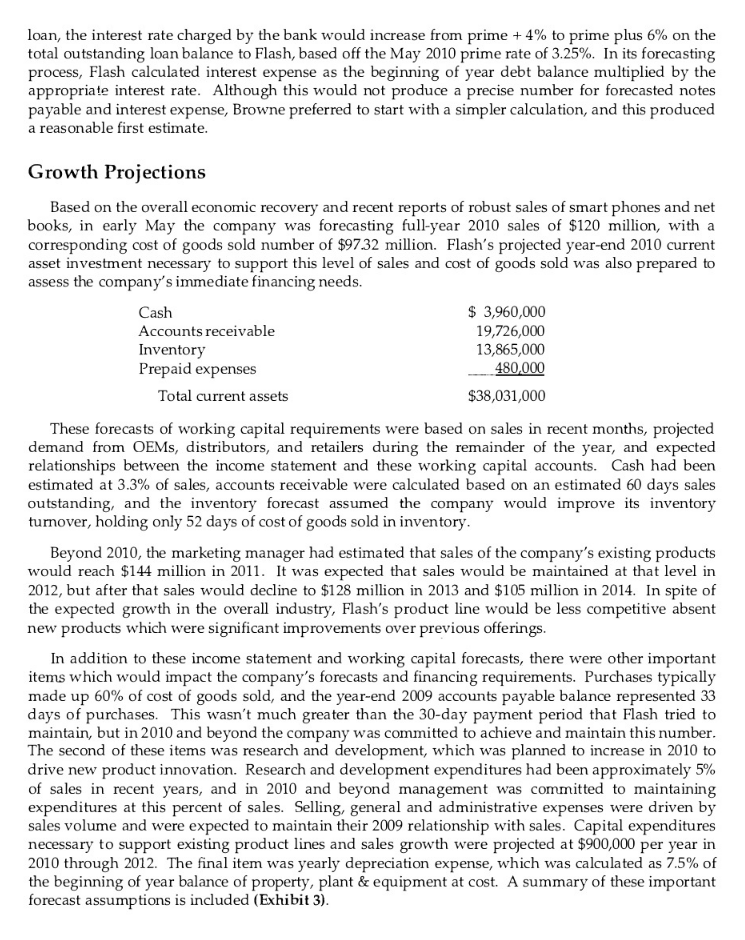
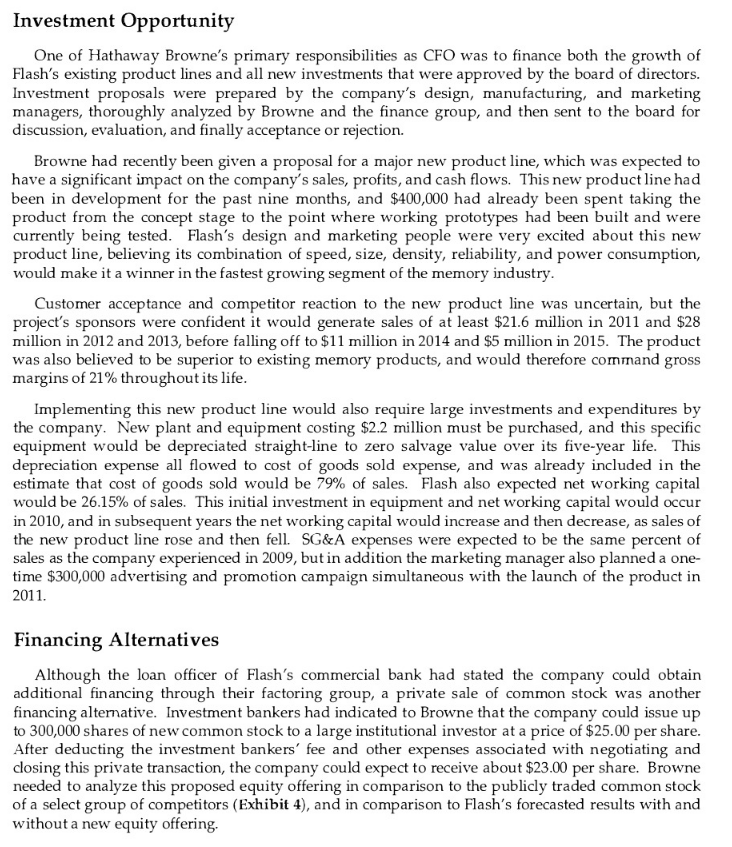
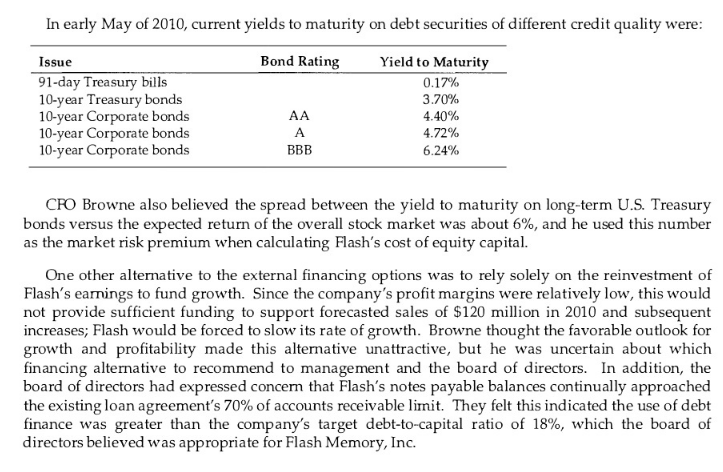
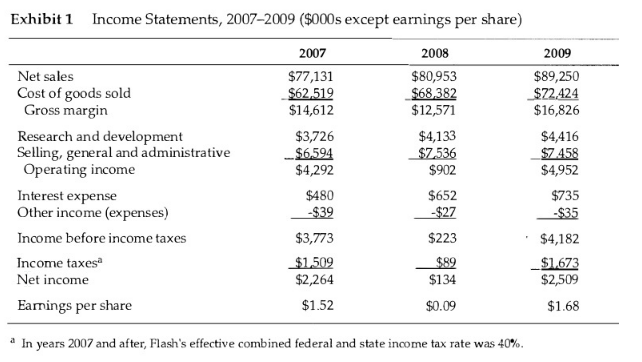
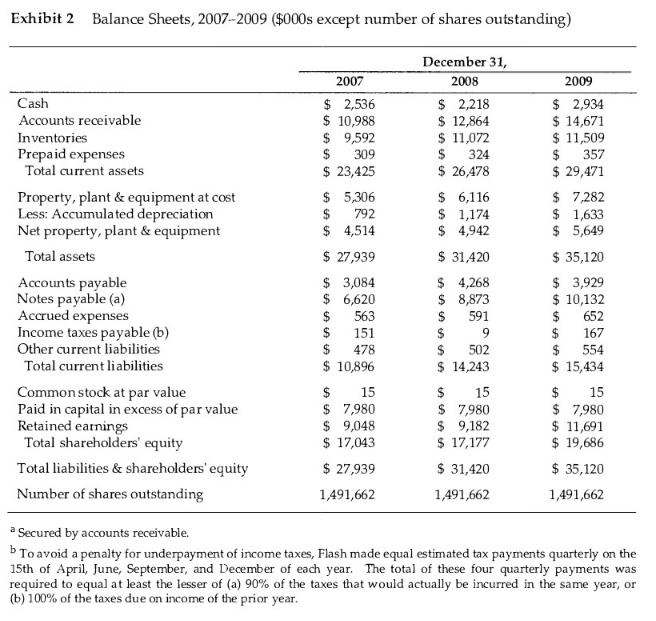

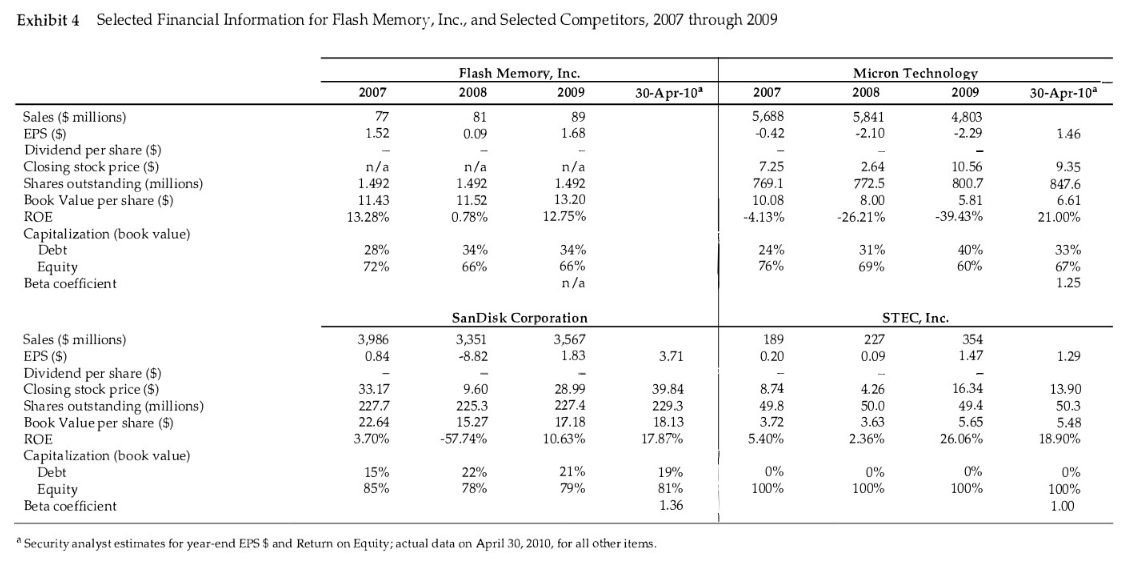
QUESTIONS:
a. Assuming the company does not invest in the new product line, prepare forecasted income statements and Balance sheets at year-end 2010, 2011, and 2012. Based on these forecasts, estimate Flashs required external financing: in this case all required external financing takes the form of additional notes payable from its commercial bank, for the same period.
b. What course of action do you recommend regarding the proposed investment in the new product line? Should the company accept or reject this investment opportunity?
c. How does your recommendation from question 2 above impact your estimate of the companys forecasted income statements and balance sheets, and required external financing in 2010, 2011, and 2012? How do these forecasted income statements and balance sheets differ if the company relies solely on additional notes payable from its commercial bank, compared to a sale of new equity?
d. As CFO of Hathaway Browne, what financing alternative would you recommend to the board of directors to meet the financing needs you estimated in questions 1 through 3 above? What are the costs and benefits of each alternative?
Flash Memory, Inc. In May of 2010, Hathaway Browne, the CFO of Flash Memory, Inc., was preparing the company's investing and financing plans for the next three years. As a small firm operating in the computer and electronic device memory market, Flash competed in product markets that reflected fast growth, continuous technological change, short product life cycles, changing customer wants and needs, a large number of competitors, and a high level of rivalry within the industry. These factors combined to produce low profit margins and a continual need for additional working capital, which adversely impacted Flash's financial position and its ability to finance important investment opportunities. Background Flash was founded in San Jose, California, by four electrical engineers during the high tech boom of the late 1990s. The common stock of the company was originally owned 100% by the founders, and additional shares were subsequently sold to two engineers who joined the company as both employees and owners. In 2010 these six individuals held the top management positions, comprised the board of directors, and still owned the entire equity in the firm. The company had enjoyed considerable success since its creation. As computers and other electronic devices became increasingly complex and powerful, the demand for high performance components, particularly memory, increased rapidly. From its founding, Flash had focused on solid state drives (SSDs), which comprised the fastest growing segment in the overall memory industry. Industry data showed the SSD market grew from approximately $400 million in 2007 to $1.1 billion in 2009, and was further projected to grow to $2.8 billion in 2011 and $5.3 billion in 2013. SSDs were particularly well suited for use in smart phones, laptop computers, and net books, and sales of these products were expected to drive this robust growth. Flash was just one of many companies in the industry. Giants like Intel and Samsung, as well as smaller specialized firms like Micron Technology, SanDisk Corporation, and STEC, Inc., all saw the industry's potential and competed for market share. This resulted in intense competition between product offerings, high rivalry, and low profit margins as a percent of sales. In the spring of 2010, Flash specialized in the design and manufacture of SSDs and memory modules that were sold to original equipment manufacturers (OEMs), distributors, and retailers and ended up in computers, computing systems, and other electronic devices. Flash's memory components, which constituted 80% of company revenue, utilized flash memory technology-a non- volatile memory that is faster, uses less power, is more resistant to failure when compared with traditional hard disk drives, and continues to store information even after an electronic device is turned off. The remaining 20% of Flash's sales came from other high performance electronic components sold through the same channels, for the same end products. Due to changes in technology, Flash's memory and other products experienced short product life cycles. The company's new products typically realized 70% of their maximum sales level in their first year, and maximum sales were reached and maintained in the second and third years. Years four and beyond saw rapidly decaying sales, and by year six the products were obsolete. This normal sales life cycle for the company's products, however, could be significantly shortened by technologically superior new products released by competitors. In a few instances Flash's products quickly became worthless, forcing significant inventory write-downs and reductions in profit. Flash responded to the risk of technological changes in the industry by aggressive spending on research and development to improve its existing product lines and add new ones. The company had successfully recruited and retained a highly skilled group of research engineers and scientists, and the activities of this group had been supported by substantial budgetary allocations. This combination of ample funding of an exceptional staff had resulted in high quality products which were well-respected by customers and competitors alike. Top management believed the reputation of Flash's products was one of its key competitive advantages, and they were determined to maintain this reputation through continued research and development expenditures. The success of Flash's memory components had resulted in compounded average annual sales growth of 7.6% per year since 2007 (Exhibit 1), and its investment in current assets had grown even faster, at a 12.2% compounded average annual rate over the same period (Exhibit 2). Flash had used notes payable obtained from the company's commercial bank, and secured by the pledge of accounts receivable, to fund this growth of working capital. Although these notes payable were technically short-term loans, in actuality they represented permanent financing, as the company continually relied on these loans to finance both existing operations and new investments. The bank was willing to lend up to 70% of the face value of receivables, and this funding arrangement had been satisfactory until recently, when the company's bank note payable balances had reached this 70% limit. The bank loan officer had made it clear to Browne that Flash had reached the limit of the bank's ability to extend credit under the terms of the current loan agreement. As general economic conditions improved in the first few months of 2010, Flash's sales increased rapidly, and the company continued to generate profits in approximately the same percentage of sales as in 2009. Unfortunately this rapid sales growth had also required a large increase in working capital, and internal cash flow had not been sufficient to fund this increase in receivables and inventories. The bank's position on extending additional financing remained the same, and when approached in May about extending additional credit to the company, the loan officer had been unwilling to do so. The loan officer did, however, discuss the factoring division of the bank with Browne, which serviced higher-risk custo mers with more aggressive accounts ivable financing. The factoring group would lend up to 90% of a company's existing accounts receivable balances, but this group would also monitor Flash's credit extension policies and accounts receivable collection activities more rigorously than the commercial loan department that currently managed the company's loan agreement. Because of the additional risk and greater cost associated with closer monitoring of the loan, the interest rate charged by the bank would increase from prime + 4% to prime plus 6% on the total outstanding loan balance to Flash, based off the May 2010 prime rate of 3.25%. In its forecasting process, Flash calculated interest expense as the beginning of year debt balance multiplied by the appropriate interest rate. Although this would not produce a precise number for forecasted notes payable and interest expense, Browne preferred to start with a simpler calculation, and this produced a reasonable first estimate. Growth Projections Based on the overall economic recovery and recent reports of robust sales of smart phones and net books, in early May the company was forecasting full-year 2010 sales of $120 million, with a corresponding cost of goods sold number of $97.32 million. Flash's projected year-end 2010 current asset investment necessary to support this level of sales and cost of goods sold was also prepared to assess the company's immediate financing needs. Cash $ 3,960,000 Accounts receivable 19,726,000 Inventory 13,865,000 Prepaid expenses 480,000 Total current assets $38,031,000 These forecasts of working capital requirements were based on sales in recent months, projected demand from OEMs, distributors, and retailers during the remainder of the year, and expected relationships between the income statement and these working capital accounts. Cash had been estimated at 3.3% of sales, accounts receivable were calculated based on an estimated 60 days sales outstanding, and the inventory forecast assumed the company would improve its inventory tumover, holding only 52 days of cost of goods sold in inventory. Beyond 2010, the marketing manager had estimated that sales of the company's existing products would reach $144 million in 2011. It was expected that sales would be maintained at that level in 2012, but after that sales would decline to $128 million in 2013 and $105 million in 2014. In spite of the expected growth in the overall industry, Flash's product line would be less competitive absent new products which were significant improvements over previous offerings. In addition to these income statement and working capital forecasts, there were other important items which would impact the company's forecasts and financing requirements. Purchases typically made up 60% of cost of goods sold, and the year-end 2009 accounts payable balance represented 33 days of purchases. This wasn't much greater than the 30-day payment period that Flash tried to maintain, but in 2010 and beyond the company was committed to achieve and maintain this number. The second of these items was research and development, which was planned to increase in 2010 to drive new product innovation. Research and development expenditures had been approximately 5% of sales in recent years, and in 2010 and beyond management was committed to maintaining expenditures at this percent of sales. Selling, general and administrative expenses were driven by sales volume and were expected to maintain their 2009 relationship with sales. Capital expenditures necessary to support existing product lines and sales growth were projected at $900,000 per year in 2010 through 2012. The final item was yearly depreciation expense, which was calculated as 7.5% of the beginning of year balance of property, plant & equipment at cost. A summary of these important forecast assumptions is included (Exhibit 3). Investment Opportunity One of Hathaway Browne's primary responsibilities as CFO was to finance both the growth of Flash's existing product lines and all new investments that were approved by the board of directors. Investment proposals were prepared by the company's design, manufacturing, and marketing managers, thoroughly analyzed by Browne and the finance group, and then sent to the board for discussion, evaluation, and finally acceptance or rejection. Browne had recently been given a proposal for a major new product line, which was expected to have a significant impact on the company's sales, profits, and cash flows. This new product line had been in development for the past nine months, and $400,000 had already been spent taking the product from the concept stage to the point where working prototypes had been built and were currently being tested. Flash's design and marketing people were very excited about this new product line, believing its combination of speed, size, density, reliability, and power consumption, would make it a winner in the fastest growing segment of the memory industry. Customer acceptance and competitor reaction to the new product line was uncertain, but the project's sponsors were confident it would generate sales of at least $21.6 million in 2011 and $28 million in 2012 and 2013, before falling off to $11 million in 2014 and $5 million in 2015. The product was also believed to be superior to existing memory products, and would therefore command gross margins of 21% throughout its life. Implementing this new product line would also require large investments and expenditures by the company. New plant and equipment costing $2.2 million must be purchased, and this specific equipment would be depreciated straight-line to zero salvage value over its five-year life. This depreciation expense all flowed to cost of goods sold expense, and was already included in the estimate that cost of goods sold would be 79% of sales. Flash also expected net working capital would be 26.15% of sales. This initial investment in equipment and net working capital would occur in 2010, and in subsequent years the net working capital would increase and then decrease, as sales of the new product line rose and then fell. SG&A expenses were expected to be the same percent of sales as the company experienced in 2009, but in addition the marketing manager also planned a one- time $300,000 advertising and promotion campaign simultaneous with the launch of the product in 2011. Financing Alternatives Although the loan officer of Flash's commercial bank had stated the company could obtain additional financing through their factoring group, a private sale of common stock was another financing alternative. Investment bankers had indicated to Browne that the company could issue up to 300,000 shares of new common stock to a large institutional investor at a price of $25.00 per share. After deducting the investment bankers' fee and other expenses associated with negotiating and closing this private transaction, the company could expect to receive about $23.00 per share. Browne needed to analyze this proposed equity offering in comparison to the publicly traded common stock of a select group of competitors (Exhibit 4), and in comparison to Flash's forecasted results with and without a new equity offering. In early May of 2010, current yields to maturity on debt securities of different credit quality were: Bond Rating Issue 91-day Treasury bills 10-year Treasury bonds 10-year Corporate bonds 10-year Corporate bonds 10-year Corporate bonds Yield to Maturity 0.17% 3.70% 4.40% 4.72% 6.24% AA A BBB CFO Browne also believed the spread between the yield to maturity on long-term U.S. Treasury bonds versus the expected return of the overall stock market was about 6%, and he used this number as the market risk premium when calculating Flash's cost of equity capital. One other alternative to the external financing options was to rely solely on the reinvestment of Flash's earnings to fund growth. Since the company's profit margins were relatively low, this would not provide sufficient funding to support forecasted sales of $120 million in 2010 and subsequent increases; Flash would be forced to slow its rate of growth. Browne thought the favorable outlook for growth and profitability made this alternative unattractive, but he was uncertain about which financing alternative to recommend to management and the board of directors. In addition, the board of directors had expressed concern that Flash's notes payable balances continually approached the existing loan agreement's 70% of accounts receivable limit. They felt this indicated the use of debt finance was greater than the company's target debt-to-capital ratio of 18%, which the board of directors believed was appropriate for Flash Memory, Inc. Exhibit 1 Income Statements, 20072009 ($000s except earnings per share) 2007 2008 2009 Net sales $77,131 $80,953 $89,250 Cost of goods sold $62,519 $68,382 $72,424 Gross margin $14,612 $12,571 $16,826 Research and development $3,726 $4,133 $4,416 Selling, general and administrative $6,594 $7.536 $7458 Operating income $4,292 $902 $4,952 Interest expense $480 $652 $735 Other income (expenses) -$39 -$27 -$35 Income before income taxes $3,773 $223 $4,182 Income taxes $1.509 $89 _$1,673 Net income $2,264 $134 $2,509 Earnings per share $1.52 $0.09 $1.68 a In years 2007 and after, Flash's effective combined federal and state income tax rate was 40%. Exhibit 2 Balance Sheets, 2007-2009 ($000s except number of shares outstanding) 2007 2009 $ 2,536 $ 10,988 $ 9,592 $ 309 $ 23,425 $ 5,306 $ 792 $ 4,514 December 31, 2008 $ 2,218 $ 12,864 $ 11,072 $ 324 $ 26,478 $ 6,116 $ 1,174 $ 4,942 $ 27,939 $ 31,420 Cash Accounts receivable Inventories Prepaid expenses Total current assets Property, plant & equipment at cost Less: Accumulated depreciation Net property, plant & equipment Total assets Accounts payable Notes payable (a) Accrued expenses Income taxes payable (b) Other current liabilities Total current liabilities Common stock at par value Paid in capital in excess of par value Retained earnings Total shareholders' equity Total liabilities & shareholders' equity Number of shares outstanding $ 4,268 $ 8,873 $ 591 $ 9 $ 502 $ 14,243 $ 2,934 $ 14,671 $ 11,509 $ 357 $ 29,471 $ 7,282 $ 1,633 $ 5,649 $ 35,120 $ 3,929 $ 10,132 $ 652 $ 167 $ $ 15,434 $ 15 $ 7,980 $ 11,691 $ 19,686 $ 35,120 1,491,662 $ 3,084 $ 6,620 $ 563 $ 151 $ 478 $ 10,896 $ 15 $ 7,980 $ 9,048 $ 17,043 $ 27,939 1,491,662 554 $ 15 $ 7,980 $ 9,182 $ 17,177 $ 31,420 1,491,662 a Secured by accounts receivable. b To avoid a penalty for underpayment of income taxes, Flash made equal estimated tax payments quarterly on the 15th of April, June, September, and December of each year. The total of these four quarterly payments was required to equal at least the lesser of (a) 90% of the taxes that would actually be incurred in the same year, or (b) 100% of the taxes due on income of the prior year. Exhibit 3 Key Forecasting Assumptions and Relationships for 2010 Through 2012 Line Item Cost of goods sold Research and development Selling, general and administrative Interest expense Other income (expenses) Cash Accounts receivable Inventories Prepaid expenses Property, plant & equipment at cost Accumulated depreciation Accounts payable Purchases Accrued expenses Income taxes payable Other current liabilities Assumption or Ratio 81.10% of sales 5.0% of sales 8.36% of sales Beginning of year debt balance x interest rate $50,000 of expense each year 3.3% of sales 60 days sales outstanding 52 days of cost of good sold 0.4% of sales Beginning PP&E at cost + capital expenditures Beginning A/D + 7.5% of beginning PP&E at cost 30 days of purchases 60% of cost of goods sold 0.73% of sales 10% of income taxes expense 0.62% of sales Exhibit 4 Selected Financial Information for Flash Memory, Inc., and Selected Competitors, 2007 through 2009 Flash Memory, Inc. 2008 2009 Micron Technology 2008 2009 2007 30-Apr-10 2007 30-Apr-10 77 1.52 81 0.09 89 1.68 5,688 -0.42 5,841 -2.10 4.803 -2.29 1.46 Sales ($ millions) EPS ($) Dividend per share ($) Closing stock price ($) Shares outstanding (millions) Book Value per share ($) n/a 1.492 11.43 13.28% n/a 1.492 11.52 0.78% n/a 1.492 13.20 12.75% 7.25 769.1 10.08 -4.13% 9.35 847.6 2.64 772.5 8.00 -26.21% 10.56 800.7 5.81 -39.43% 6.61 ROE 21.00% Capitalization (book value) Debt Equity Beta coefficient 28% 72% 34% 66% 34% 66% n/a 24% 76% 31% 69% 40% 60% 33% 67% 1.25 STEC, Inc. 3,986 0.84 SanDisk Corporation 3,351 3,567 -8.82 1.83 189 0.20 227 0.09 354 1.47 3.71 1.29 Sales ($ millions) EPS ($) Dividend per share ($) Closing stock price ($) Shares outstanding (millions) Book Value per share ($) ROE Capitalization (book value) Debt Equity Beta coefficient 33.17 227.7 22.64 3.70% 9.60 225.3 15.27 -57.74% 28.99 227.4 17.18 10.63% 39.84 229.3 18.13 17.87% 8.74 49.8 3.72 5.40% 4.26 50.0 3.63 2.36% 16.34 49.4 5.65 26.06% 13.90 50.3 5.48 18.90% 15% 85% 22% 78% 21% 79% 19% 81% 1.36 0% 100% 0% 100% 0% 100% 0% 100% 1.00 Security analyst estimates for year-end EPS $ and Return on Equity; actual data on April 30, 2010, for all other items. Flash Memory, Inc. In May of 2010, Hathaway Browne, the CFO of Flash Memory, Inc., was preparing the company's investing and financing plans for the next three years. As a small firm operating in the computer and electronic device memory market, Flash competed in product markets that reflected fast growth, continuous technological change, short product life cycles, changing customer wants and needs, a large number of competitors, and a high level of rivalry within the industry. These factors combined to produce low profit margins and a continual need for additional working capital, which adversely impacted Flash's financial position and its ability to finance important investment opportunities. Background Flash was founded in San Jose, California, by four electrical engineers during the high tech boom of the late 1990s. The common stock of the company was originally owned 100% by the founders, and additional shares were subsequently sold to two engineers who joined the company as both employees and owners. In 2010 these six individuals held the top management positions, comprised the board of directors, and still owned the entire equity in the firm. The company had enjoyed considerable success since its creation. As computers and other electronic devices became increasingly complex and powerful, the demand for high performance components, particularly memory, increased rapidly. From its founding, Flash had focused on solid state drives (SSDs), which comprised the fastest growing segment in the overall memory industry. Industry data showed the SSD market grew from approximately $400 million in 2007 to $1.1 billion in 2009, and was further projected to grow to $2.8 billion in 2011 and $5.3 billion in 2013. SSDs were particularly well suited for use in smart phones, laptop computers, and net books, and sales of these products were expected to drive this robust growth. Flash was just one of many companies in the industry. Giants like Intel and Samsung, as well as smaller specialized firms like Micron Technology, SanDisk Corporation, and STEC, Inc., all saw the industry's potential and competed for market share. This resulted in intense competition between product offerings, high rivalry, and low profit margins as a percent of sales. In the spring of 2010, Flash specialized in the design and manufacture of SSDs and memory modules that were sold to original equipment manufacturers (OEMs), distributors, and retailers and ended up in computers, computing systems, and other electronic devices. Flash's memory components, which constituted 80% of company revenue, utilized flash memory technology-a non- volatile memory that is faster, uses less power, is more resistant to failure when compared with traditional hard disk drives, and continues to store information even after an electronic device is turned off. The remaining 20% of Flash's sales came from other high performance electronic components sold through the same channels, for the same end products. Due to changes in technology, Flash's memory and other products experienced short product life cycles. The company's new products typically realized 70% of their maximum sales level in their first year, and maximum sales were reached and maintained in the second and third years. Years four and beyond saw rapidly decaying sales, and by year six the products were obsolete. This normal sales life cycle for the company's products, however, could be significantly shortened by technologically superior new products released by competitors. In a few instances Flash's products quickly became worthless, forcing significant inventory write-downs and reductions in profit. Flash responded to the risk of technological changes in the industry by aggressive spending on research and development to improve its existing product lines and add new ones. The company had successfully recruited and retained a highly skilled group of research engineers and scientists, and the activities of this group had been supported by substantial budgetary allocations. This combination of ample funding of an exceptional staff had resulted in high quality products which were well-respected by customers and competitors alike. Top management believed the reputation of Flash's products was one of its key competitive advantages, and they were determined to maintain this reputation through continued research and development expenditures. The success of Flash's memory components had resulted in compounded average annual sales growth of 7.6% per year since 2007 (Exhibit 1), and its investment in current assets had grown even faster, at a 12.2% compounded average annual rate over the same period (Exhibit 2). Flash had used notes payable obtained from the company's commercial bank, and secured by the pledge of accounts receivable, to fund this growth of working capital. Although these notes payable were technically short-term loans, in actuality they represented permanent financing, as the company continually relied on these loans to finance both existing operations and new investments. The bank was willing to lend up to 70% of the face value of receivables, and this funding arrangement had been satisfactory until recently, when the company's bank note payable balances had reached this 70% limit. The bank loan officer had made it clear to Browne that Flash had reached the limit of the bank's ability to extend credit under the terms of the current loan agreement. As general economic conditions improved in the first few months of 2010, Flash's sales increased rapidly, and the company continued to generate profits in approximately the same percentage of sales as in 2009. Unfortunately this rapid sales growth had also required a large increase in working capital, and internal cash flow had not been sufficient to fund this increase in receivables and inventories. The bank's position on extending additional financing remained the same, and when approached in May about extending additional credit to the company, the loan officer had been unwilling to do so. The loan officer did, however, discuss the factoring division of the bank with Browne, which serviced higher-risk custo mers with more aggressive accounts ivable financing. The factoring group would lend up to 90% of a company's existing accounts receivable balances, but this group would also monitor Flash's credit extension policies and accounts receivable collection activities more rigorously than the commercial loan department that currently managed the company's loan agreement. Because of the additional risk and greater cost associated with closer monitoring of the loan, the interest rate charged by the bank would increase from prime + 4% to prime plus 6% on the total outstanding loan balance to Flash, based off the May 2010 prime rate of 3.25%. In its forecasting process, Flash calculated interest expense as the beginning of year debt balance multiplied by the appropriate interest rate. Although this would not produce a precise number for forecasted notes payable and interest expense, Browne preferred to start with a simpler calculation, and this produced a reasonable first estimate. Growth Projections Based on the overall economic recovery and recent reports of robust sales of smart phones and net books, in early May the company was forecasting full-year 2010 sales of $120 million, with a corresponding cost of goods sold number of $97.32 million. Flash's projected year-end 2010 current asset investment necessary to support this level of sales and cost of goods sold was also prepared to assess the company's immediate financing needs. Cash $ 3,960,000 Accounts receivable 19,726,000 Inventory 13,865,000 Prepaid expenses 480,000 Total current assets $38,031,000 These forecasts of working capital requirements were based on sales in recent months, projected demand from OEMs, distributors, and retailers during the remainder of the year, and expected relationships between the income statement and these working capital accounts. Cash had been estimated at 3.3% of sales, accounts receivable were calculated based on an estimated 60 days sales outstanding, and the inventory forecast assumed the company would improve its inventory tumover, holding only 52 days of cost of goods sold in inventory. Beyond 2010, the marketing manager had estimated that sales of the company's existing products would reach $144 million in 2011. It was expected that sales would be maintained at that level in 2012, but after that sales would decline to $128 million in 2013 and $105 million in 2014. In spite of the expected growth in the overall industry, Flash's product line would be less competitive absent new products which were significant improvements over previous offerings. In addition to these income statement and working capital forecasts, there were other important items which would impact the company's forecasts and financing requirements. Purchases typically made up 60% of cost of goods sold, and the year-end 2009 accounts payable balance represented 33 days of purchases. This wasn't much greater than the 30-day payment period that Flash tried to maintain, but in 2010 and beyond the company was committed to achieve and maintain this number. The second of these items was research and development, which was planned to increase in 2010 to drive new product innovation. Research and development expenditures had been approximately 5% of sales in recent years, and in 2010 and beyond management was committed to maintaining expenditures at this percent of sales. Selling, general and administrative expenses were driven by sales volume and were expected to maintain their 2009 relationship with sales. Capital expenditures necessary to support existing product lines and sales growth were projected at $900,000 per year in 2010 through 2012. The final item was yearly depreciation expense, which was calculated as 7.5% of the beginning of year balance of property, plant & equipment at cost. A summary of these important forecast assumptions is included (Exhibit 3). Investment Opportunity One of Hathaway Browne's primary responsibilities as CFO was to finance both the growth of Flash's existing product lines and all new investments that were approved by the board of directors. Investment proposals were prepared by the company's design, manufacturing, and marketing managers, thoroughly analyzed by Browne and the finance group, and then sent to the board for discussion, evaluation, and finally acceptance or rejection. Browne had recently been given a proposal for a major new product line, which was expected to have a significant impact on the company's sales, profits, and cash flows. This new product line had been in development for the past nine months, and $400,000 had already been spent taking the product from the concept stage to the point where working prototypes had been built and were currently being tested. Flash's design and marketing people were very excited about this new product line, believing its combination of speed, size, density, reliability, and power consumption, would make it a winner in the fastest growing segment of the memory industry. Customer acceptance and competitor reaction to the new product line was uncertain, but the project's sponsors were confident it would generate sales of at least $21.6 million in 2011 and $28 million in 2012 and 2013, before falling off to $11 million in 2014 and $5 million in 2015. The product was also believed to be superior to existing memory products, and would therefore command gross margins of 21% throughout its life. Implementing this new product line would also require large investments and expenditures by the company. New plant and equipment costing $2.2 million must be purchased, and this specific equipment would be depreciated straight-line to zero salvage value over its five-year life. This depreciation expense all flowed to cost of goods sold expense, and was already included in the estimate that cost of goods sold would be 79% of sales. Flash also expected net working capital would be 26.15% of sales. This initial investment in equipment and net working capital would occur in 2010, and in subsequent years the net working capital would increase and then decrease, as sales of the new product line rose and then fell. SG&A expenses were expected to be the same percent of sales as the company experienced in 2009, but in addition the marketing manager also planned a one- time $300,000 advertising and promotion campaign simultaneous with the launch of the product in 2011. Financing Alternatives Although the loan officer of Flash's commercial bank had stated the company could obtain additional financing through their factoring group, a private sale of common stock was another financing alternative. Investment bankers had indicated to Browne that the company could issue up to 300,000 shares of new common stock to a large institutional investor at a price of $25.00 per share. After deducting the investment bankers' fee and other expenses associated with negotiating and closing this private transaction, the company could expect to receive about $23.00 per share. Browne needed to analyze this proposed equity offering in comparison to the publicly traded common stock of a select group of competitors (Exhibit 4), and in comparison to Flash's forecasted results with and without a new equity offering. In early May of 2010, current yields to maturity on debt securities of different credit quality were: Bond Rating Issue 91-day Treasury bills 10-year Treasury bonds 10-year Corporate bonds 10-year Corporate bonds 10-year Corporate bonds Yield to Maturity 0.17% 3.70% 4.40% 4.72% 6.24% AA A BBB CFO Browne also believed the spread between the yield to maturity on long-term U.S. Treasury bonds versus the expected return of the overall stock market was about 6%, and he used this number as the market risk premium when calculating Flash's cost of equity capital. One other alternative to the external financing options was to rely solely on the reinvestment of Flash's earnings to fund growth. Since the company's profit margins were relatively low, this would not provide sufficient funding to support forecasted sales of $120 million in 2010 and subsequent increases; Flash would be forced to slow its rate of growth. Browne thought the favorable outlook for growth and profitability made this alternative unattractive, but he was uncertain about which financing alternative to recommend to management and the board of directors. In addition, the board of directors had expressed concern that Flash's notes payable balances continually approached the existing loan agreement's 70% of accounts receivable limit. They felt this indicated the use of debt finance was greater than the company's target debt-to-capital ratio of 18%, which the board of directors believed was appropriate for Flash Memory, Inc. Exhibit 1 Income Statements, 20072009 ($000s except earnings per share) 2007 2008 2009 Net sales $77,131 $80,953 $89,250 Cost of goods sold $62,519 $68,382 $72,424 Gross margin $14,612 $12,571 $16,826 Research and development $3,726 $4,133 $4,416 Selling, general and administrative $6,594 $7.536 $7458 Operating income $4,292 $902 $4,952 Interest expense $480 $652 $735 Other income (expenses) -$39 -$27 -$35 Income before income taxes $3,773 $223 $4,182 Income taxes $1.509 $89 _$1,673 Net income $2,264 $134 $2,509 Earnings per share $1.52 $0.09 $1.68 a In years 2007 and after, Flash's effective combined federal and state income tax rate was 40%. Exhibit 2 Balance Sheets, 2007-2009 ($000s except number of shares outstanding) 2007 2009 $ 2,536 $ 10,988 $ 9,592 $ 309 $ 23,425 $ 5,306 $ 792 $ 4,514 December 31, 2008 $ 2,218 $ 12,864 $ 11,072 $ 324 $ 26,478 $ 6,116 $ 1,174 $ 4,942 $ 27,939 $ 31,420 Cash Accounts receivable Inventories Prepaid expenses Total current assets Property, plant & equipment at cost Less: Accumulated depreciation Net property, plant & equipment Total assets Accounts payable Notes payable (a) Accrued expenses Income taxes payable (b) Other current liabilities Total current liabilities Common stock at par value Paid in capital in excess of par value Retained earnings Total shareholders' equity Total liabilities & shareholders' equity Number of shares outstanding $ 4,268 $ 8,873 $ 591 $ 9 $ 502 $ 14,243 $ 2,934 $ 14,671 $ 11,509 $ 357 $ 29,471 $ 7,282 $ 1,633 $ 5,649 $ 35,120 $ 3,929 $ 10,132 $ 652 $ 167 $ $ 15,434 $ 15 $ 7,980 $ 11,691 $ 19,686 $ 35,120 1,491,662 $ 3,084 $ 6,620 $ 563 $ 151 $ 478 $ 10,896 $ 15 $ 7,980 $ 9,048 $ 17,043 $ 27,939 1,491,662 554 $ 15 $ 7,980 $ 9,182 $ 17,177 $ 31,420 1,491,662 a Secured by accounts receivable. b To avoid a penalty for underpayment of income taxes, Flash made equal estimated tax payments quarterly on the 15th of April, June, September, and December of each year. The total of these four quarterly payments was required to equal at least the lesser of (a) 90% of the taxes that would actually be incurred in the same year, or (b) 100% of the taxes due on income of the prior year. Exhibit 3 Key Forecasting Assumptions and Relationships for 2010 Through 2012 Line Item Cost of goods sold Research and development Selling, general and administrative Interest expense Other income (expenses) Cash Accounts receivable Inventories Prepaid expenses Property, plant & equipment at cost Accumulated depreciation Accounts payable Purchases Accrued expenses Income taxes payable Other current liabilities Assumption or Ratio 81.10% of sales 5.0% of sales 8.36% of sales Beginning of year debt balance x interest rate $50,000 of expense each year 3.3% of sales 60 days sales outstanding 52 days of cost of good sold 0.4% of sales Beginning PP&E at cost + capital expenditures Beginning A/D + 7.5% of beginning PP&E at cost 30 days of purchases 60% of cost of goods sold 0.73% of sales 10% of income taxes expense 0.62% of sales Exhibit 4 Selected Financial Information for Flash Memory, Inc., and Selected Competitors, 2007 through 2009 Flash Memory, Inc. 2008 2009 Micron Technology 2008 2009 2007 30-Apr-10 2007 30-Apr-10 77 1.52 81 0.09 89 1.68 5,688 -0.42 5,841 -2.10 4.803 -2.29 1.46 Sales ($ millions) EPS ($) Dividend per share ($) Closing stock price ($) Shares outstanding (millions) Book Value per share ($) n/a 1.492 11.43 13.28% n/a 1.492 11.52 0.78% n/a 1.492 13.20 12.75% 7.25 769.1 10.08 -4.13% 9.35 847.6 2.64 772.5 8.00 -26.21% 10.56 800.7 5.81 -39.43% 6.61 ROE 21.00% Capitalization (book value) Debt Equity Beta coefficient 28% 72% 34% 66% 34% 66% n/a 24% 76% 31% 69% 40% 60% 33% 67% 1.25 STEC, Inc. 3,986 0.84 SanDisk Corporation 3,351 3,567 -8.82 1.83 189 0.20 227 0.09 354 1.47 3.71 1.29 Sales ($ millions) EPS ($) Dividend per share ($) Closing stock price ($) Shares outstanding (millions) Book Value per share ($) ROE Capitalization (book value) Debt Equity Beta coefficient 33.17 227.7 22.64 3.70% 9.60 225.3 15.27 -57.74% 28.99 227.4 17.18 10.63% 39.84 229.3 18.13 17.87% 8.74 49.8 3.72 5.40% 4.26 50.0 3.63 2.36% 16.34 49.4 5.65 26.06% 13.90 50.3 5.48 18.90% 15% 85% 22% 78% 21% 79% 19% 81% 1.36 0% 100% 0% 100% 0% 100% 0% 100% 1.00 Security analyst estimates for year-end EPS $ and Return on Equity; actual data on April 30, 2010, for all other items
Step by Step Solution
There are 3 Steps involved in it
Step: 1

Get Instant Access to Expert-Tailored Solutions
See step-by-step solutions with expert insights and AI powered tools for academic success
Step: 2

Step: 3

Ace Your Homework with AI
Get the answers you need in no time with our AI-driven, step-by-step assistance
Get Started


